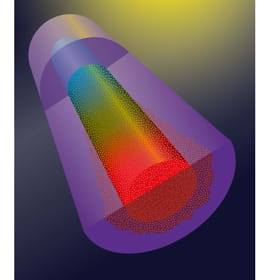New way to control electric currents within nano-scale materials

- Bolstered by Research Consortium with Drexel, Jefferson’s Sidney Kimmel Cancer Center Earns NCI Comprehensive Cancer Center Designation
- No link between acetaminophen use during pregnancy and children's autism risk
- Drexel Recognizes Gregory E. Deavens, CPA, CGMA as Business Leader of the Year
- Through Connections and Community, Drexel Course Helps Launch Computer Lab in Tanzania

A team of researchers in Drexel’s Department of Materials Science & Engineering led by Dr. Jonathan Spanier and their collaborators in Italy have discovered a new way to manipulate the flow of electrons within different components of a nano-scale material. This new information could lead to the creation of sophisticated circuitry in much smaller scale that would drastically reduce the size of computers and other related technology.
The group has reported on “tuning” the flow of electrons between the core and a surrounding shell of a tiny co-axial cylindrical nanowire. The result is an electrical resistance that is not only negative, but remarkably adjustable, a feature not normally present in individual resistive devices. Integrated circuits, essential to computers and technology for performing complex functions, possess many smaller device elements including those which require a sizable area to store sufficient electric charge.
These new findings, as reported this week in Physical Review Letters, hold promise for realizing sophisticated functions, such as those involving timing and processing signals, within simple nano-scale components. This result opens the possibility for integrated circuits, essential building blocks of computers, to be constructed with far fewer and smaller components that generate less heat, and waste less energy.
“Aside from the potential for nanoscale devices having rich functions, the study also manifests itself as an approach to better understand the interface between materials in the nano-scale,” said Guannan Chen, a doctoral student who is one of Spanier’s collaborators in the research.
Supported the National Science Foundation and the U.S. Army Research Office the team came upon this new information while investigating the flow of electrons through nanowires each consisting of a core and a shell, finding that they could control how and when an excited or “hot” electron relaxes or “cools,” either in the core where the hot electron was produced, or into the neighboring shell. This is what researchers call “tuning” the electron transfer.
"Advanced solar cells include those that harness the excess energy associated with hot electrons that are produced and need to be transferred efficiently when higher-energy photons are incident upon a multi-component nano-scale material,” Spanier said. “By introducing three different ways in which we can independently control electron transfer we have a new framework for investigating the relaxation of hot electrons in nano-scale materials, and in turn, for designing nanostructured solar cells with higher efficiency.”
In addition to Chen, the research team includes Eric Gallo, Oren Leaffer and Terrence McGuckin, graduate students at Drexel and Paola Prete from Consiglio Nazionale delle Ricerche in Lecce, Italy as well as Nico Lovergine from the Unviersity of Salento also in Lecce Italy.
In This Article
Contact
Drexel News is produced by
University Marketing and Communications.